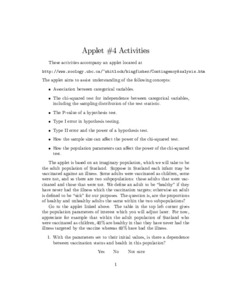
Chi-squared Contingency Analysis
(0)This web visualisation illustrates concepts of association and independence for categorical variables, applications of the chi-squared test, and type I and II errors in hypothesis testing.
Prerequisite Knowledge
- Distinguish between a population and a sample, and between parameters and statistics.
- Interpret a population proportion.
- Recall that hypothesis tests involved both null and alternative hypotheses.
Learning Objectives
- Identify when either association or independence exists between two binary categorical variables in a population.
- Describe the shape of the sampling distribution of the test statistic for a chi-squared test of association.
- Interpret the P-value for a chi-squared test of association.
- Identify when either a type I or II error occurs in a chi-squared test of association, given the population parameter values.
- Describe how the sample size can affect the power of a chi-squared test.
- Describe how the population parameters can affect the power of the chi-squared test.
Description
Code: https://www.zoology.ubc.ca/~whitlock/Kingfisher/
This web visualisation allows learners to explore both the association between categorical variables and certain concepts related to hypothesis tests. The context is sampling from a fictitious population that is split into two subpopulations (vaccinated and unvaccinated), within each of which a certain proportion are “healthy’’. The proportion healthy within each subpopulation may be selected by the user and random samples of different sizes selected. For each sample, the chi-squared test statistic is computed along with its P-value. Multiple samples may be selected in order to explore how the test statistic varies, and how type I and II error rates vary with sample size and parameter values.
Suggested Uses, Tips and Discoveries
As research suggests learners may need supporting activities in order to gain learning from an applet, an activity is provided to enhance student engagement with the applet. The activity can be attempted by students individually or working in small groups. The activity takes about thirty minutes of class time, although we found much variability in the time taken for students to attempt the activity if working individually.
We learned a lot about this resource from trialling with students. Both one-one interviews and focus groups were used to gauge students’ learning and opinions of the applet. Details of our findings are included in a file for the resource, “Interview&FocusGroupFeedback’’.
Creator
- Whitlock, Michael
Resource Type
Date Created
Date Approved
Access
Everyone
https://statspace.elearning.ubc.ca/handle/123456789/326


Comments
Ratings in detail